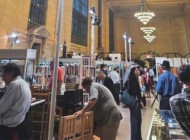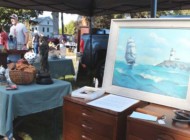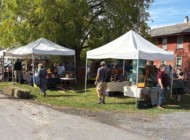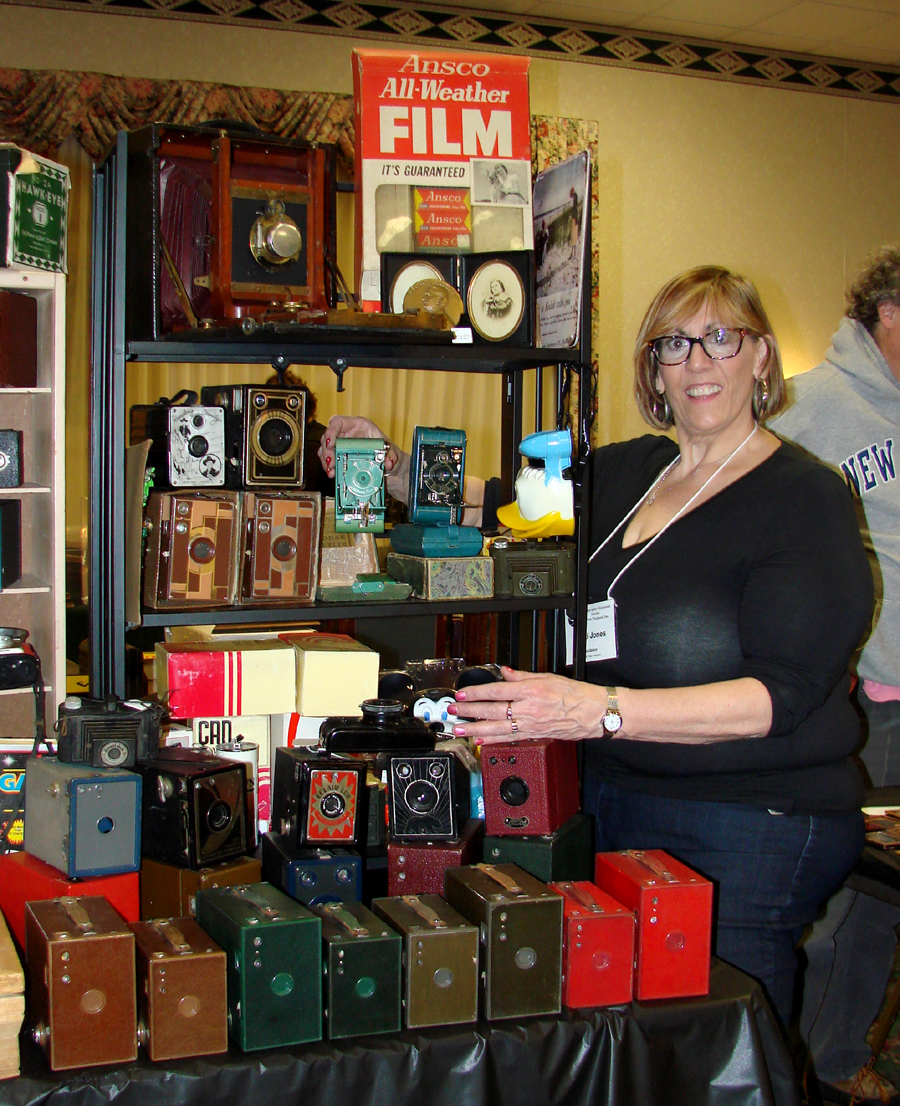
Marti Jones has one hand resting on an apple-green Kodak “Petite Ensemble.” The ensembles were made in the 1930s specifically to appeal to women and were packaged with lipstick and rouge. It was priced at $650.
Photographic Historical Society Of New England
Review And Photos by Rick Russack
NEWTON, MASS. — One might expect that Photographica 85, conducted at American Legion Post 440 here on April 2, would be a small, local show, given its name. But it is not. Exhibitors come from as far away as Virginia, Pennsylvania and New York. And buyers respond. Aisles were crowded shortly after the show opened and exhibitors were writing up sales from the start. Some had already had a good show by the time it opened for regular admissions at 9 am.
The organization promoted the show extensively, both in print and online, and by offering free admission to students, so there were a number of young photography bugs in the room. Veterans were also admitted free. Buyers could choose from cameras, daguerreotypes, ambrotypes, tintypes, stereoviews, lenses, photographic literature, accessories, albums of albumen prints and some unusual items. Offerings included vintage equipment, plus much that could be used by present-day photographers.
The Photographic Historical Society of New England (PHSNE) was formed in 1973, during the early days of interest in vintage photographica. It conducts monthly meetings with a speaker on a subject of interest to its members. It also publishes The New England Journal of Photographic History, an annual bulletin, with articles on the history of photography and collecting. Shortly after its founding, the organization started to produce shows, and this year, the show had more than 70 dealers with 85 tables. Two popular features of the shows are an auction of items consigned by members and “Dollar Tables,” with inexpensive photographic accessories, etc.
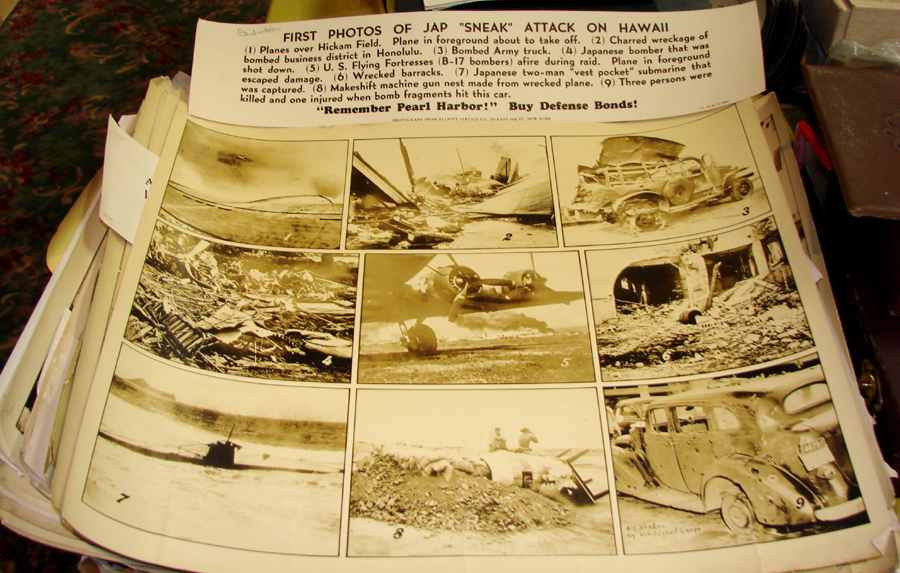
Marti Jones, Manchester, N.H., had a group of World War II news photographs, including one showing Pearl Harbor after the bombing. Her price for the lot was $300.
Perhaps one of the most unusual items seen this edition was a circa 1904 Edison Kinetoscope, an early projector for movies. Edison was an early experimenter with moving pictures, beginning in the 1890s, and held several patents on various details of the technology. He also experimented with combining movies with his cylinder photographs, producing a combination machine he called a “Kinetophone,” but it was not commercially successful.
Rhode Island dealer/collector Peter Shultz brought the machine, which was in fine condition and said that devices of this type were used by itinerant showmen, who would travel from town to town, putting on exhibitions in schools and churches. In those early days, moving pictures were a newly developed form of entertainment and most people, especially in small towns, had never seen one. The device that Schultz was offering could show 35mm movies and could also project magic lantern slides. Schultz said that he has owned a camera shop for more than 60 years and, as a collector, is especially drawn to early cameras and those that represent some type of landmark in the history of photography.
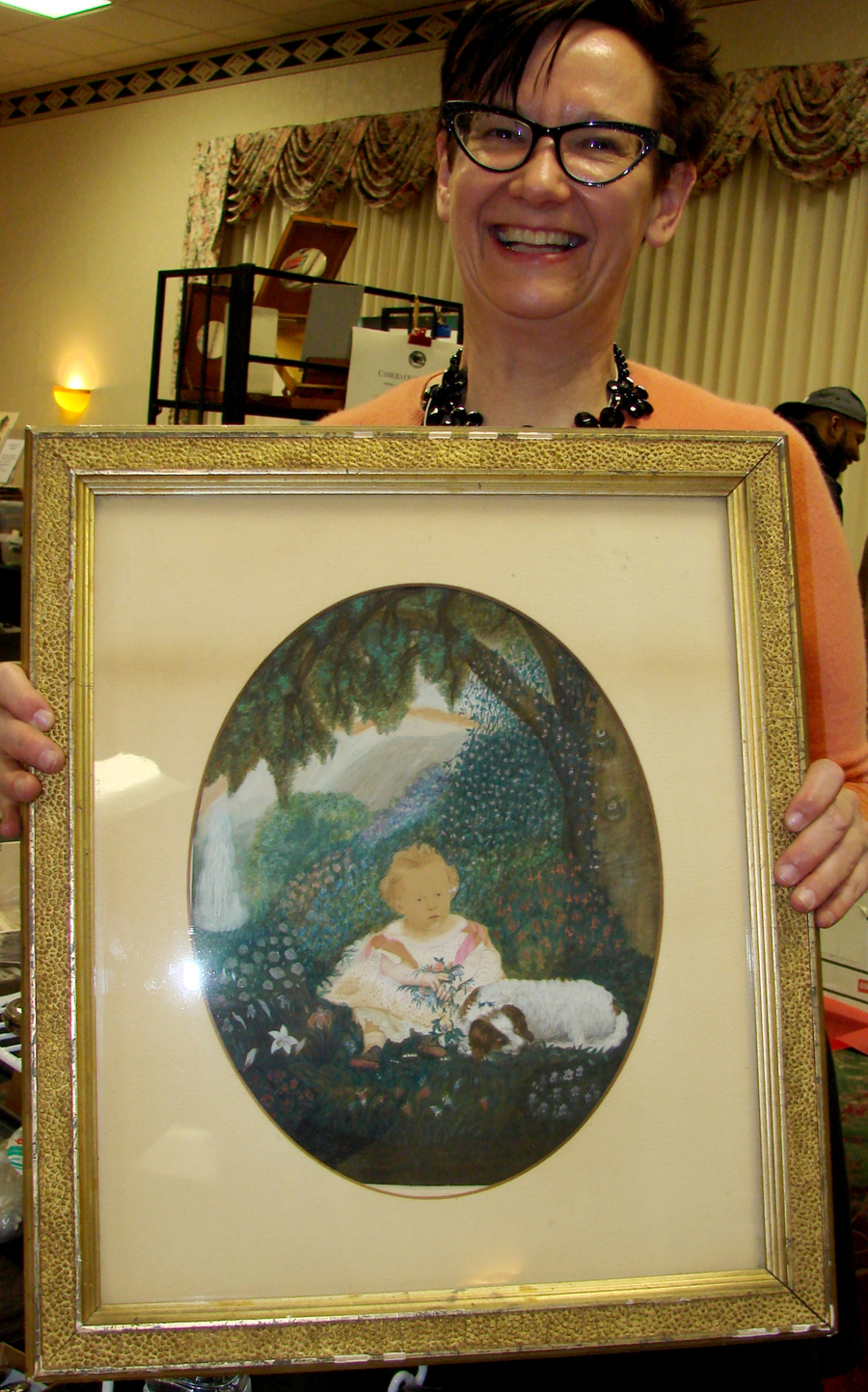
Sabine Ocker offered a hand colored salt print that looked like a folk painting for $100. It sold early in the show.
Those whose interest was in daguerreotypes and other images had many from which to choose. Prices for daguerreotypes ranged from $20 for simple portraits to $15,000 for a 1/6 plate image of a skull, courtesy of Rochester, N.Y., dealer Josh Heller. Greg French, well-known specialist in Nineteenth Century photographs from Jamaica Plain, Mass., offered a 1/6th plate daguerreotype of Daniel Webster at $8,500 and a 1/6th plate daguerreotype of a black woman holding a white child on her lap. That was priced at $3,000.
French also had wide selection of stereo views, priced from $12 for scenic views of the White Mountains to more than $500 for Civil War views. He also offered stereoviews of Native Americans taken by John Hillers on the second Powell Survey of the Colorado River in the early 1870s. One view titled “Woman Grinding Corn” was priced at $190, and French was asking $235 for a stereo portrait of “The Maiden, U-In-Tats.” Views of Boston, Africa, bridges, etc, were available.
Bob Cooke was offering his collection of more than 200 autochromes, which were one of the first attempts at producing color photographs. Developed in the early Twentieth Century, the process was capable of producing high-quality color photographs on glass plates. The process was not simple, exposures had to be long, so moving subjects could not be photographed, and the quality of available autochromes vary widely. The process fell out of favor when Kodak introduced Kodachrome film in the 1930s. Cooke has been diligently collecting for more than ten years and had an album showing most of his collection. He was hoping to sell the entire collection but did not want to discuss price.
Larry Rochette, a Marlboro, Mass., dealer whose involvement with PHSNE goes back to its beginning, offered a French Kino Sept camera for $350. Developed in the 1920s, this camera could also be used for taking movies or as a projector. So-called “detective” cameras, designed to allow candid shots, were offered by several dealers. A Blair “Hawkeye” was available from Peter Shultz for $325. Some collectors just seek out “detective” cameras as some were ingeniously designed to look like anything but a camera.
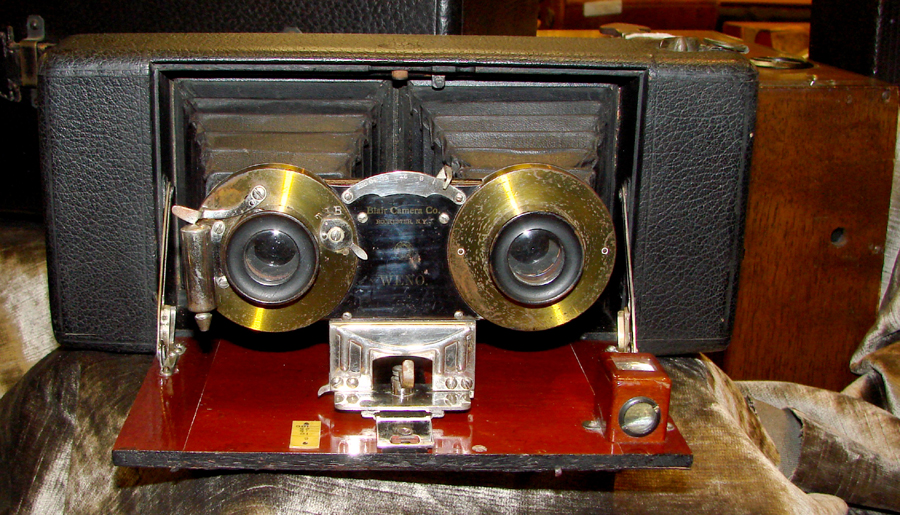
According to Peter Shultz, the black bellows on this stereo camera indicate that it was the first stereo model made by the Blair Camera Company of Boston. He dated it to 1901 and was asking $525 for it. The Blair company was successful for several years, but was acquired by Kodak around 1907.
Many of the attendees, especially younger ones, were photographers and were seeking vintage, but useable, large-format film cameras and lenses. As with images, prices varied widely depending on scarcity and condition. There were hundreds of lenses for sale with prices starting as low as $20. Tom Degnan sold a Leica R3 Safari outfit, circa 1976, for $1,500 and he had Leica lenses priced between $200 and $400. An early Sony AX 2000 video camera kit was priced at $2,000 and a Number Five Kodak cartridge film camera, circa 1895, was priced at $300.
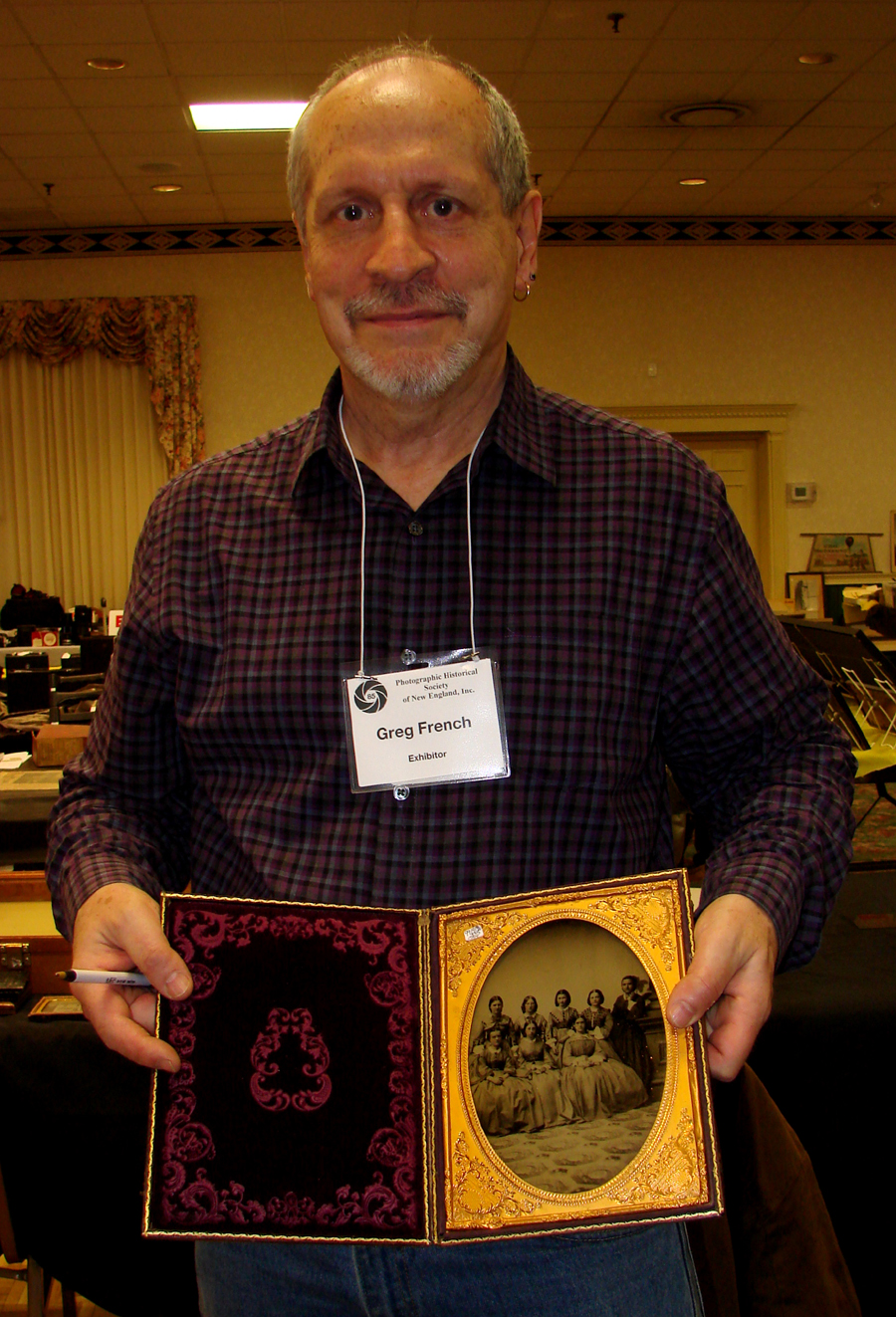
Greg French, from Jamaica Plain, Mass., holds a full plate ambrotype with eight people. The circa 1859 image was priced at $2,500.
Show manager John Dockery discussed the show with Antiques and The Arts Weekly. “Most of the dealers told me that they had a good show and will be back next year,” he reported. “In past years, afternoon attendance slacked off, but this year we were strong all day. Our offer of free admission for students worked well, and we had more women than we’ve seen in the past. We tried to make it a pleasant experience for all, offering free bagels and coffee in the morning and free ice cream and cake in the afternoon.
“It was a good day for sales of roll film cameras,” he continued. “Also, 4-by-5 cameras did well and so did Rolleiflex cameras. Some 8-by-10 glass plate and film cameras also sold. Many of these sold to the younger crowd, who want to get back to using film. It wasn’t surprising that darkroom supplies were selling, as the same younger people want to be able to develop their own film. We promoted the show heavily on social media — you have to do that these days. It’s where the young crowd is.”
Dockery added that the event’s auction went well and offered some nice things. “Sadly, some of our older members are dying off and the auction provides a good outlet for stuff they’ve collected. This was our first show in the new facility and we learned some things. The aisles were a little tight, so next year we’ll be expanding, using a second room and we’ll have room for more dealers. With happy dealers and a good crowd, I’d certainly call it a good day.”
In addition to being a place to buy cameras or images, it was also a place to learn. Several dealers were engaged in conversations with the younger collectors, discussing the fine points of lenses or cameras or techniques of using some of the older equipment.
PHSNE’s next show will be conducted in April 2017. For information, www.phsne.org or 781-893-0843.
Gallery
[slideshow_deploy id=’1000266027′]
